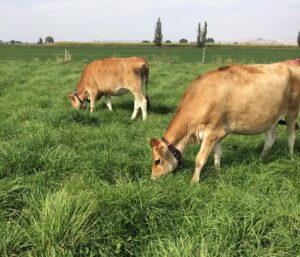Project Overview
Commodities
- Agronomic: grass (misc. perennial)
- Animals: bovine
- Animal Products: dairy
Practices
- Animal Production: grazing - rotational
- Crop Production: nutrient cycling
- Production Systems: organic agriculture
Abstract:
In 2019, there were over 3.6 million dairy cows in the western U.S. [1], making dairy a dominant sector of the region’s agriculture. Organic milk production is becoming more prevalent, with organic products increasing from 1.92% to 4.38%, of all milk products sold, between 2006 and 2013 [2]. Organic milk companies promote their product based upon the health and environmental benefits of pasture-raised milk [3], and require at least 120 grazing days per year for both lactating cows and replacement heifers [4]. However, milk production is 32% lower in dairies using 75-100% of pasture-based forage compared to those using 25% or less pasture forage [5]. Insufficient dry matter intake (DMI) of pasture by dairy cows is a major factor limiting milk production [6], and it has been observed that some dairy breeds are more efficient grazers than others [7-9]. Therefore, improved feed efficiency - the relative ability of a cow to convert feed into growth or milk, is increasingly important in pasture-based dairy systems [10, 11].
This proposal expands our previous Western SARE projects that evaluated how grass-legume pastures with different energy, protein, and condensed tannin (CT) levels affected beef steer and Jersey heifer growth performance (SW10-088 and SW17-046). Those studies found that forage characteristics only explained 50% of the variation in DMI and average daily gain (ADG) [12, 13]. Furthermore, producers on our research team asked about the influence of dairy breed on performance within their pasture-based systems. Thus, we propose to investigate the effects of dairy breed, pasture type, and breed-by-pasture type interactions on DMI, feed efficiency, and environmental and economic sustainability of heifers raised in pasture-based systems. A multi-disciplinary team will conduct this research at the Utah State University Lewiston Pasture Research Facility where replicated pastures of grass monoculture (MONO) or grass-birdsfoot trefoil (MIXED) are established. Four breeds of dairy heifers (Holstein, Jersey, Holstein/Jersey crossbreds, and 3-way Holstein/Montbeliarde/Viking Red crossbreds [i.e., ProCROSS]) will be compared as they rotationally graze pasture treatments (MONO vs MIXED) throughout the summer. Producer cooperators will provide dairy heifers and participate in DMI and forage evaluation of pastures on their dairies.
[caption id="attachment_666492" align="alignnone" width="300"] WSARE SW17-046[/caption]
WSARE SW17-046[/caption]
[caption id="attachment_666493" align="alignnone" width="300"] WSARE SW10-088[/caption]
WSARE SW10-088[/caption]
Outreach is a major component of the proposal with contributions from university extension and eOrganic. This program will integrate traditional outreach with electronic media and be guided by input from producer cooperators and similar stakeholders. The primary targeted audiences will be dairy producers, Extension educators, NRCS personnel, and other professionals who advise farmers/ranchers. Emphasis will be on providing opportunities to train these individuals in the local area, statewide, and across the western region.
These objectives are in direct response to stakeholder feedback and are expected to identify differences in feed efficiency. It is anticipated that some breeds will respond to both high quality (MIXED) and lesser quality (MONO) pastures, whereas, some breeds will respond only to high-quality pastures. At the end of the research, we expect to provide producers with solid scientific AND economic data on pasture-based dairy heifer development for a variety of pasture-types and dairy breeds.
Project objectives:
RESEARCH OBJECTIVES
Our long-term goal is to enhance the sustainability of pasture-based dairy. The central hypothesis of the current proposal is that genetic background (“breed”) will have a significant influence on the physiological responses of dairy heifers grazing grass/birdsfoot trefoil (MIXED) or grass-only (MONO) pastures, and these differences will be reflected in measures of environmental and economic sustainability. Specific research objectives are:
1: Determine the influence of dairy breed on DMI and feed efficiency in heifers grazing either grass-monoculture or grass/birdsfoot trefoil mixed pastures. We hypothesize that DMI and feed efficiency will differ across breeds but will be greater in MIXED pastures compared to MONO pastures for all breeds. We also anticipate that some breeds will have greater feed efficiency relative to other breeds on lesser quality pastures.
2: Evaluate the influence of dairy breed on nutrient leaching when grazing either grass-monoculture or grass/birdsfoot trefoil mixed pastures. We hypothesize that animals grazing the pastures with the CT-containing birdsfoot trefoil (MIXED) will have improved nitrogen (N) utilization as measured by reduced N in groundwater leachate compared to those grazing grass monocultures, and that greater feed efficiency will be associated with greater N-utilization efficiency.
3: Ascertain the influence of dairy breed on the economic sustainability of pasture-based heifer development. We hypothesize that heifer breed/pasture type combinations with relatively greater feed efficiency will have greater annual net financial impact and reduced payback period.
EDUCATION OBJECTIVES
As part of our long-term goal to enhance the sustainability of pasture-based dairy, we will implement an innovative and impactful multi-faceted extension/outreach program on the production and environmental benefits of pasture-based dairy heifer development. Pasture-based milk production is a fast-growing segment of agriculture in the Intermountain West and this project will bridge the gap in urgently needed information regarding breed and pasture-type differences. We have devised a solid research plan that will generate a wealth of highly novel data across a very broad and multidisciplinary research spectrum. The results from this study will be of value to the scientific and pasture-based dairy farming communities in general, but our research/outreach effort is designed to translate this information to make a real difference to individual dairy farmers and their families throughout the Intermountain West. Specific education objectives are:
1: Implement an innovative and impactful multi-faceted extension/outreach program for producers and professionals in the local area, statewide, and across the western region on the production, environmental, and economic benefits of grass/legume grazing for pasture-based dairy production systems.
2: Create and pilot the Intermountain Regional Dairy Grazing School.
3: Produce and publish scholarly and educational products.